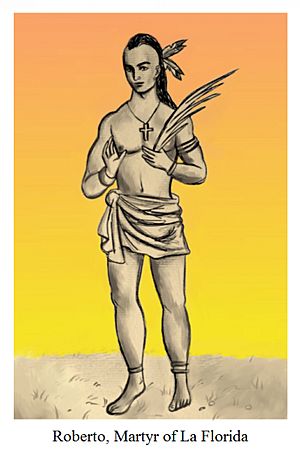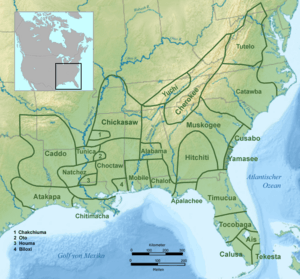Yamasee facts for kids
| Total population | |
|---|---|
| Extinct as tribe | |
| Regions with significant populations | |
| Languages | |
| Yamasee language (extinct) | |
| Religion | |
| Yamasee tribal religion | |
| Related ethnic groups | |
| La Tama, Guale, Seminole, Hitchiti, and other Muskogean tribes |
The Yamasees (also called Yamassees or Yemassees) were a group of Native American tribes. They lived near the coast in what is now northern Georgia, close to the Savannah River. Later, they moved to northeastern Florida. The Yamasees were involved in many fights and wars with other native groups and European settlers. These conflicts happened across a wide area, from Florida to North Carolina.
Many experts believe the Yamasees spoke a Muskogean language. This is based on clues from their language. For example, the Yamasee word "Mico" means chief, which is also a common word in the Muskogee language.
After the Yamasees moved to the Carolinas, they started taking part in the Indian slave trade in the American Southeast. They would raid other tribes to capture people. These captives were then sold to European colonists. Some Native Americans who were captured were sent to work on plantations in the West Indies. Their enemies fought back, and this slave trading was a major reason for the Yamasee War.
Contents
History of the Yamasee People
Early Life and Migrations
The Yamasees lived in towns along the coast. These areas are now parts of southeast Georgia, Florida (which the Spanish called La Florida), and South Carolina. In the late 1500s, the Yamasees moved from Spanish Florida to South Carolina. There, they became friends with the European colonists. Members of the Guale tribe, who were part of a Mississippian culture chiefdom, joined the Yamasees. Their cultures began to mix together.
Contact with Europeans
Spanish Encounters
In 1540, the Hernando de Soto expedition traveled through Yamasee lands. They visited a village called Altamaha.

Spanish explorers built missions in Yamasee territory starting in 1570. The Yamasees were later included in the missions of the Guale area. From 1675 onwards, the Spanish regularly mentioned the Yamasees in their mission records. These records were for the Guale and Mocama missionary areas. The Yamasees usually did not become Christians. They stayed somewhat separate from the Catholic Christian Native Americans in Spanish Florida.
In 1680, pirate attacks on the Spanish missions forced the Yamasees to move again. Some went to Florida. Others returned to the Savannah River lands. These lands were safer after the Westo tribe had been defeated.
English Connections
In 1687, some Spanish tried to send captured Yamasees to the West Indies as slaves. The Yamasee tribe fought back against the Spanish missions and their Native allies. They then moved into the English colony of Carolina, which is now South Carolina. They built several villages there, including Pocotaligo, Tolemato, and Topiqui, in Beaufort County. In 1715, a count by an Irish colonist named John Barnwell found 1,220 Yamasees. They lived in ten villages near Port Royal.
The Yamasees started moving to Charles Town (in the Carolina colony) in 1686. They likely did this to trade with English colonists or to escape the Spanish. In Charles Town, some Yamasee families wanted Christian missionaries to teach their children. They hoped their children would learn to read and write and become Christians. Christian missionaries in Carolina might have had some success. This was because the Yamasees and Guale were already familiar with Spanish missionaries. They were more open to becoming Christians than other tribes.
Yamasee War and Its Effects
For many years, Yamasee fighters raided Spanish-allied Native American tribes in the American Southeast. They often used European guns and worked with settlers from Carolina. The Yamasees also attacked the Spanish settlement of St. Augustine. Native Americans captured by the Yamasees were sent to colonial towns in Carolina. There, they were sold to white colonists. Many of these captives were then sold again to slave farms in the West Indies.
Many Yamasees soon owed money to the colonists they traded with. This happened because of unfair trading practices by the colonists. The Yamasees became very angry about these practices. They decided to go to war against the colonists. They formed a large group with many other tribes. On April 15, 1715, they started a two-year war by attacking the colonial town of Charles Town.
The Yamasees had many Native American tribes join their group. They launched big attacks against other colonial settlements in Carolina. This caused most colonists to leave their frontier homes and seek safety in Charles Town. South Carolina Governor Charles Craven led a force that defeated the Yamasees at Salkechuh (also called Saltketchers or Salkehatchie) on the Combahee River. Eventually, Craven was able to push the Yamasees across the Savannah River and back into Spanish Florida.
After the war, the Yamasees moved south. They went to the areas around St. Augustine and Pensacola. There, they made an alliance with the Spanish government. These Yamasees continued to live in Florida until 1727. At that time, a combination of a smallpox sickness and attacks by Col. John Palmer (leading fifty Carolina soldiers and one hundred Native Americans) caused many of the remaining Yamasees to scatter. Some joined the Seminole or Creek tribes. Others stayed near St. Augustine until the Spanish gave control of the city to the British. When this happened, the Spanish took about 90 Yamasees with them to Havana.
Yamasee Culture
Steven J. Oatis and other historians say the Yamasees were a mix of several Native American groups. These included the Guale, La Tama, Apalachee, Coweta, and Cussita Creek, among others. Historian Chester B. DePratter describes the Yamasee towns in early South Carolina. He says there were Lower Towns, mostly made up of Hitchiti-speaking Native Americans. There were also Upper Towns, mainly made up of Guale Native Americans.
Slavery and Raids
The Yamasees were one of the largest slave raiding tribes in the American Southeast in the late 1600s. They have been called a "militaristic slaving society." This means they were a strong group that used raids to capture people. They got guns from European colonists. Their use of slave raids to control other tribes is partly because the Yamasee wanted to stay independent. It was common for Native Americans to take captives during wars, especially young women and children. But the Yamasees soon started sending their captives to Carolina to sell in Charles Town's slave markets. They began to raid specifically to capture people and sell them in Carolina.
Diplomacy and Relations
In 1713, Anglican missionaries in South Carolina helped a Yamasee man travel to London. His real name is not known, but he was often called the "prince" or "Prince George." Historians say the "prince" visited London as a form of "religious diplomacy." The missionaries hoped to strengthen ties between the Yamasee and British colonists. They believed that if the "prince" became a Christian in London, the Yamasee would become strong allies of the British. Around the time the "prince" traveled to London, the Yamasees generally did not want to be culturally absorbed by the Spanish. Instead, they chose to keep stronger connections with British colonists. The "prince" returned to Charles Town in 1715. This was right when the Yamasee War began. Shortly after his return, his family had been captured by Carolina raiders and sold into slavery.
Archaeological Research
The Yamasee Archeological Project started in 1989. Its goal was to study Yamasee village sites in South Carolina. The project hoped to find out where the people came from and to list their artifacts. The project found about a dozen sites. Pocosabo and Altamaha have since been listed as important archaeological sites on the National Register of Historic Places.
Yamasee Language
| Yamasee | |
|---|---|
| Region | Georgia |
| Extinct | 18th century |
| Language family |
unclassified; perhaps Guale
|

Tribal territory of the Yamasees during the seventeenth century
|
|
The name "Yamasee" might come from the Muskogee word yvmvsē, meaning "tame, quiet." Or it might come from the Catawban word yį musí:, which means "people-ancient."
Very little information remains about the Yamasee language. Some parts of it are kept in the writings of missionary Domingo Báez. Diego Peña was told in 1716-1717 that the Cherokee of Tuskegee Town also spoke Yamasee.
Hann (1992) said that Yamasee is related to the Muskogean languages. This idea came from an old report. It said that a Yamasee spy in a Hitchiti town could understand Hitchiti and was not found out as a Yamasee. Francis Le Jau said in 1711 that the Yamasee understood Creek. He also noted that many Native Americans in the area used Creek and Shawnee as lingua francas. These were common languages for trading. In 1716-1717, Diego Peña learned that Yamasee and Hitchiti-Mikasuki were seen as separate languages.
The Yamasee language was similar to many Muskogean languages. It was especially similar to Creek, sharing many words. Many Spanish missionaries in La Florida wanted to learn native languages like Yamasee. They did this to communicate and convert people to Christianity. It also helped missionaries learn about the people's own religion. This allowed them to find ways to share Christian ideas.
There is limited evidence that suggests the Yamasee language was similar to Guale. This evidence is not strong enough to be certain. It is based on three pieces of information:
- a copy of a 1681 Florida missions census. It says that the people of Nuestra Señora de la Candelaria de la Tama speak "la lengua de Guale, y Yamassa" (the Guale and Yamasee language).
- a summary of two letters from 1688, sent by the Spanish Florida governor. It mentions prisoners speaking the "ydioma Yguala y Yamas, de la Prova de Guale" (the Yguala and Yamas language of the province of Guale).
- the Guale called the Cusabo Chiluque. This word is probably related to the Muscogee word čiló·kki, meaning "Red Moiety."
Linguists note that the Spanish documents are not the originals. They might have been changed later. The name Chiluque is probably a word borrowed from another language. It seems to have also been used in the Timucua language. So, the idea that Yamasee is connected to Muskogean languages is not fully supported.
A document in a British archive suggests that the Yamasees originally spoke Cherokee. Cherokee is an Iroquoian language. But the document says they had learned another language. For a time, they were allied with the Cherokee. However, they are believed to have been a different people.
Yamasee Legacy
The name Yamasee lives on in the town of Yemassee, South Carolina. This town is in the Lowcountry, close to where the Yamasee War started. The name is also used for the title of William Gilmore Simms' 1835 historical novel, The Yemassee: A Romance of Carolina. By extension, it is also used for Yemassee, the official literary journal of the University of South Carolina.
Today, there are unrecognized Yamasee groups in Florida. Also, a religious group called Nuwaubian Nation, linked to Dwight York, has used the name Yamassee Native American Moors of the Creek Nation.
Images for kids
See also
 In Spanish: Yamasi para niños
In Spanish: Yamasi para niños


